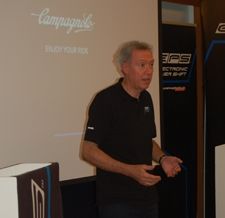TAORMINA, Sicily (BRAIN)—Campagnolo capped 20 years of research, development and engineering Monday with the unveiling of its long awaited 11-speed electronic drivetrain during a media launch in Taormina, a seaside village in the shadow of Sicily’s towering Mt. Etna.
Called Electronic Power Shift, or EPS, the system debuts commercially later this year in two versions, Super Record and Record, and consists of five components: EPS Ergopower controls that maintain Campy’s one lever action, but also include a switch mode to view battery charge level; an interface, a small box that communicates back and forth with the power unit and mounts on the stem or brake cable; the power unit, which houses the electronics and 12-volt lithium ion rechargeable battery pack; the EPS front derailleur and the EPS rear derailleur.
Pricing hasn’t been set yet, but Lorenzo Taxis, Campagnolo’s director of marketing, said the reason the company opted to release two versions is so the Super Record could be positioned at the ultra high end while the Record would compete with the cost of Shimano’s Di2 Dura-Ace system.
“We are living in a competitive market so we need to be able to compete,” he said.
Taxis said that at 2,098 grams, the Super Record version is the lightest electronic group on the market, followed by the Record at 2,184 grams. Both derailleurs incorporate a new technopolymer material with carbon fiber on the inside to keep the weight down.
The system will first be available to pro tour teams riding it next year—Movistar, Lotto and select riders from Europcar and Lampre, then will begin shipping to OEs in December, and global distributors next spring. Taxis said the bike sponsors associated with those teams—Pinarello, Colnago, Ridley and Wilier—will all spec EPS on their 2013 high-end road bikes aimed at the consumer market.
EPS will be made in Campagnolo’s three factories—its headquarters in Vicenza, Italy, and two Romanian factories, one of which opened last month to support demand for carbon fiber wheels and other products. Taxis said the factories are geared up for a production run of 250 units in December and 500 after that initial output.
Valentino Campagnolo, son of Campagnolo founder Tullio Campagnolo and current company president, said EPS is a key step as the 80-year-old Italian component manufacturer looks to remain competitive in the face of a difficult global economy. It’s clear, he said, that there is a part of the market willing to accept very advanced product.
“We’re confident it’s not a small part of our future. It will be an important part of our future,” he said. “This technology we want to develop even more in the future.” That could include a system specifically for time trial bikes, he said.
Campagnolo developed its first electronic prototype gruppo in 1992, an 8-speed system that needed an enormous battery and suffered from a lack of suitable electronic components. As Campagnolo continued to advance its mechanical drivetrain to 9, 10 and eventually 11 speeds, its electronic counterpart moved along slowly in the background. The first pro team rode it in the 2005 Giro d’ Italia, Tour de France and other classics, but engineers were sent back to the drawing board after the electronics failed when a rainstorm doused the bikes mounted on a roof rack on a team car traveling 150 kilometers per hour. Four years later, Campy introduced an 11-speed mechanical gruppo and put its energy into that project, but electronic was close, and after a final re-design, it was time to go commercial.
“The era of EPS begins today,” Taxis said.
—Nicole Formosa
nformosa@bicycleretailer.com
Photo: Campagnolo president Valentino Campagnolo speaks to media about his company's electronic drivetrain innovation.
For additional photos of the electronic group, go to the BRAIN Facebook page.




